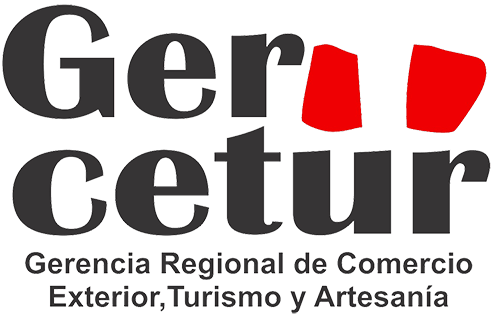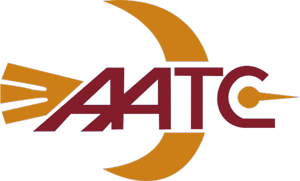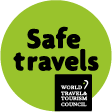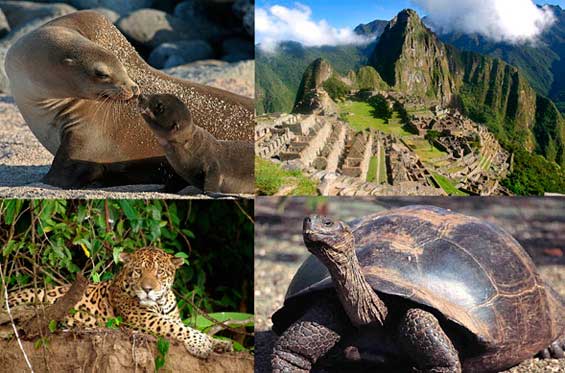
Encountering incrediblewildlife in the Galapagos Islands, swimming and snorkelling, experiencingtraditional life on Lake Titicaca, exploring Sacred Valley ruins, marvelling atthe views from the train to Machu Picchu, enjoying the wildlife in the AmazonZone of Manu Biosphere Reserve.
Experience the adventure of alifetime—and do it in style! Beginning in Quito and finishing in Lima, you'llcruise the Galapagos Islands then explore the mysterious lines of Nazca anddiscover the peaks of Incan culture and archeology high in the Andes.Explorethe Amazon enjoying the wildlife of Manu biosphere reserve. With a focus oncomfortable transportation and superior accommodation, this adventure offers agreat introduction to the region and a convenient way to explore thisincredible land in comfort..
| Day 1 Quito. Ecuador (D) | Arrive at any time. Arrival transfer included. At night we have a Welcome Dinner |
| Day 2 Baltra/Santa Cruz (B,L,D) | Vuelo a Baltra. Encuentro con el guía y la traslado através de la Isla Santa Cruz a Puerto Ayora a bordo de la embarcación. Por latarde visita la Estación Científica Charles Darwin. |
| Day 3 South Plaza/Santa Fé (B,L,D) | En la mañana Salida a la tierra en Sur Plaza para las aventura con la vida salvaje. Por la tarde visita a la Islade Santa Fe para caminatas guiadas para observar la vida silvestre y abundanteiguanas marinas. Oportunidades para nadar y bucear con lobos marinos. |
| Day 4 Floreana (B,L,D) | Land at Punta Cormorant, on Floreana Island. Guided walks to observe the bird and wildlife and learn about the natural history. Visit Post Office Bay in the afternoon. Snorkelling excusion at the Corona del Diablo. |
| Day 5 Española (B,L,D) | Visit to Punta Suarez and Gardner Bay on Española Island. Guided walksto observe wildlife and free time for swimming or snorkelling. |
| Day 6 San Cristóbal/Quito (B) | Visit the Interpretation Center on San Cristóbal Island before flyingback to Quito. |
| Day 7 Quito/Lima (B) | Fly to Lima. Transfer to Hotel.. |
| Day 8 Nazca - Arequipa (B) | Travel by private bus via Pisco to Nazca. Flight over the Nazca lines, before travelling to Arequipa |
| Day 9, Arequipa (1B) | Arrive to Arequipa, free time to explore the city. Included city tour of Arequipa and free time to explore the city and surroundings. |
| Day 10,11 Colca Cañon - Chivay- Cruz del Condor (2B) | Visit the Colca Valley and the Cruz delCondor to observe the fly over the cañon of the world's largestbird. |
| Day 12, Arequipa - Cusco (1B) | Vuelo a Cusco y traslado al hotel, día libre. |
| Day 13 Sacred Valley/Ollantaytambo (B,L) | Full-day guided tour of the Sacred Valley and Ollantaytambo ruins. Shopping opportunities at a local market.over night in Ollantaytambo |
| Day 14 Machupicchu (B) | Train to Aguas Calientes, "Machupicchu Village". Guided tour in Machu Picchu and optional visit to the Inca Bridge before returning to Cusco |
| Day 15,16,17, Manu Amazon National Park | Trip to the Cultural Zone of Manu Biosphere Reserve |
| Day 18 Cusco –Puno (B,L) | Bus to Puno, visiting the Colonial church of Andahuaylillas, and Archaeological sites with beautiful views along our trip. |
| DAY 19 Puno/Lake Titicaca (2B), | Visit to the floating Islands of Uros and guided tour of Lake Titicaca.Optional visit to Sillustani burial site. |
| Day 20 Lima (B,D) | Fly to Lima. Optional city tour or free time to explore. Last supper |
| Day 21 Lima (B) | Transfer to the airport for your depart at any time. |
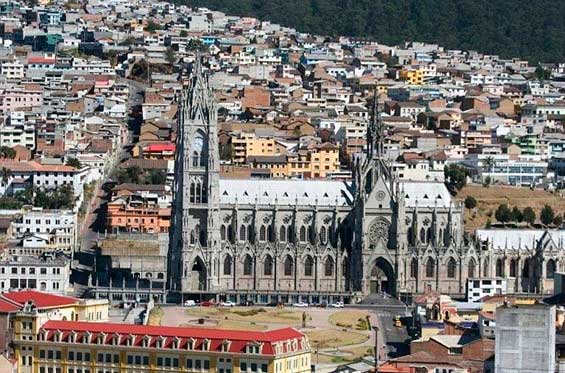
Arrive in Quito at any time and catch an included arrivaltransfer to the hotel. There are no planned activities, so check into our hoteland enjoy the city. A representative will greet you at the hotel and brief youon the various aspects of the tour. If you are not able to attend the welcomemeeting, our representative will leave all important information at yourhotel's reception indicating what time to be ready on Day 2 of your trip. Ifthere is any confusion on arrival, please do not hesitate to call the contactnumber listed in this dossier.
Located 2850m (9348 ft) above sea level, the Ecuadorian capital of Quito enjoysa wonderful spring-like climate, despite the fact that it is only 22 km (14miles) south of the Equator. Nestled in a valley flanked by mountains, on aclear day several snow-capped volcanoes, including nearby Pichincha, arevisible from the city centre. Add to its beautiful location a rich history andwell-preserved colonial district, and you begin to understand Quito's appeal tothousands of tourists every year.
In 1978 UNESCO declared Quito a World Heritage site, and any new development inQuito's old town is now strictly controlled. Life in Quito tends to bepeaceful, though the drivers are fond of using their car horns! There areapproximately 2,000,000 inhabitants in the metropolitan area, but the pace isrelaxed and the residents hospitable.
Since pre-Columbian times, the site of Quito has been inhabited by the Quitus,the Shyris and the Puruhas. The Inca reached this city before the Spaniards,but levelled it to the ground rather than give it up to the Spanish. Thepresent capital was founded by the Spanish on December 6th, 1534. Quito isseparated into two basic sections, the old and the new cities. The old city isfull of historical buildings and churches. One of the more noteworthy is theCatedral de Quito, located on the Plaza de la Independencia. Built between 1550and 1562, it was one of the first neoclassical works in Quito. La Compañía deJésus Church is considered one of the most beautiful in the Americas. Thedecorations in the Compañía contain approximately one and one-half tons ofgold, and construction of the church took 170 years (1605-1775).
There are several excellent museums scattered throughout the city. The Casa dela Cultura Ecuadoriana has an interesting display of traditional musicalinstruments and Ecuadorian traditional dress, a large art collection, and asmall natural history museum. For archaeology the best museum to visit is theMuseo del Banco Central with its well displayed pottery, gold ornaments, skullsshowing deformities and early surgical methods, a mummy and many other objectsof interest. The small, rounded hill dominating the old town is El Panecillo or'the Little Bread Loaf,' a major Quito landmark. From here there are marvellouspanoramic views of the entire city and surrounding volcanoes. You can easilytake a trolley (streetcar) or a cab between the Old Town and New Town.
Quito's large foreign population and steady stream of travellers have given ita varied and vibrant nightlife, and salsotecas and other dance clubs abound.For a real Ecuadorian experience though, be sure and drop by a peña if you can;these are great places for meeting locals and dancing, as well as enjoyinglocal cooking.
Just a couple of hours south of Quito is Parque National Cotopaxi, home toCotopaxi Volcano (5897 m/19342 ft). the beautiful cone-shaped, snow coveredvolcano is Ecuador's second highest peak and the highest active volcano in theworld. This is a great spot for a days hiking (up to the refuge on theglacier's edge) or mountain biking (downhill all the way). True enthusiastsattempt the climb to the summit (overnight excursion). Allow yourself an extraday or two in Quito, before or after your trip, if you want to conquerCotopaxi.
1st night of our trip we have a Welcome Dinner
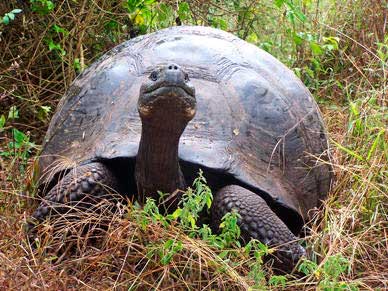
Transfer early to the airport for our flight to theGalapagos Islands. Upon arrival meet our naturalist guide, who will assist withthe transfer to the g4, moored in Puerto Ayora, Santa Cruz Island. Visit theCharles Darwin Station, see giant tortoises and learn about Charles Darwin'sstudies of Galapagos wildlife. Free time to do some shopping and exploring.
The Galapagos Islands are located about 1000 km (620 miles) off the Pacificcoast of South America. The archipelago is comprised of 13 major islands andscores of islets that served as a living laboratory for Charles Darwin, therenowned evolution theorist.
Long before Darwin arrived in the Galapagos, seafarers knew these isolatedislands as home to some of the strangest and most wonderful wildlife imaginable,including birds that could swim but no longer fly, aquatic iguanas, dragon-likelizards left over from prehistoric times, and the giant Galapagos tortoises forwhich the islands were named.
Covering nearly 5000 square km (3100 square miles), the Galapagos Islands arenow a National Park. The Galapagos National Park is the institution thatcontrols the preservation of this environment, assisted by the Charles DarwinResearch Station. Inaugurated in 1964 and based in Puerto Ayora on Santa Cruz Island,the Charles Darwin Research Station is the one place where visitors can easilysee the famous Galapagos Tortoises, which may live up to two hundred years.This is also the training centre for naturalist guides who accompany allvisitors landing at more than 40 approved sites on the islands, and members ofthe international scientific community often come to study at the station.
The National Park charges a visitor fee of $100 USD, payable on arrival, whichfunds Park maintenance and supervision in the Galapagos, as well as ecologicalstudy, conservation and infrastructure development in Ecuador's other NationalParks. Entry fees and the funds they generate for the National Park System areamong measures taken by the Ecuadorian government to protect its naturalheritage.
Santa Cruz is the most populated island within the archipelago, and PuertoAyora is its main town. The Charles Darwin Research Station is a 10 minute walkfrom the centre of the town. Here, an exhibition centre displays photos of recentvolcanic eruptions, charts outlining geological formations and drawings of theevolutionary development of endemic species. A corral houses adult GalapagosTortoises, and a nursery cares for young tortoises until they are about threeyears old, when their shells have hardened enough to resist attack from feraldogs.
Turtle Bay is a 45 minute walk from Puerto Ayora along a well establishedtrail. This pristine, white sand beach is a tranquil place, with white surfaccentuating the Caribbean blues of the deeper waters. Follow the beach to asmall peninsula; on the other side you find a large lagoon.
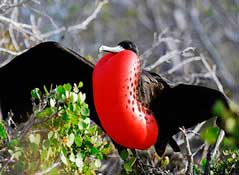
In the morning we will take an excursion to RábidaIsland, where we will land on a red sand beach. From here a short trail leadsto a salt water lagoon, often home to wading flamingos. Another trail goes pastthe lagoon to the interior, where the revered palo santo trees grow. Whenburned, the branches of this tree give off a pleasing aroma and ward offmosquitoes. Back on the beach among low-lying bushes nest theprehistoric-looking pelicans. This is the best area for close viewing of thesenesting birds, and it's a rare treat to watch parent pelicans return withgullets full of fish for the squawking youngsters.
Afternoon excursion to Bachas Beach to see the sea lions and plentiful birdlife.
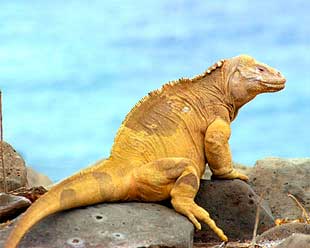
Make your way to Post Office Bay, on Floreana Island. Thehistory of Floreana Island (also called Charles) has gradually evolved to reachnear mythic proportions. The story begins when a baroness and her two lovers, aGerman doctor and his mistress, and a German couple and their young son allcame to settle on this land. Their dalliances and disasters, shrouded inmystery, were chronicled in John Treherne's book The Galapagos Affair.Descendants of the German family, the Wittmers, still live on the island in thesmall community of Puerto Velasco Ibarra. Mrs. Margaret Wittmer has alsowritten a booked entitled "Floreana" and this can be purchased at theairport in Baltra or at a local bookstore.
Morning visit to Punta Cormorant , in the afternoon we visit Post Office Baythat has an older and less mysterious history. A barrel was placed here in thelate 18th century by English whaling vessels to be used as a post office.Passing ships would stop to leave mail for loved ones, collecting at the sametime any mail destined for ports on their itineraries. Today the box is usedmainly by tourists, who may drop off and pick up unstamped letters to becarried to far destinations. The remains of a Norwegian canning factory are theonly evidence of the Island's history prior to its designation as a protectedarea. A short hike up past the post barrel takes you to an interesting lavacave. With the aid of a flashlight, you can descend about 80 m (262 ft) to thepoint where the sea enters the cave.
Later in the afternoon we make our way towards Punta Cormorant on the northernpart of Floreana. The landing is on a beach of green sand, coloured by olivinecrystals, volcanic-derived silicates of magnesium and iron. The trail leads toa lake normally inhabited by flamingos and other shore birds and continues to abeach of fine white sand particles known as "Flour Beach", an important nestingsite for turtles. Around the point, Devil's Crown derives its name from thebroken remains of a partially submerged volcanic cone. This is a perfect spotto go snorkelling from the boat, as the waters are home to a multitude ofcolourful fish and sea lions. Please make sure you are a comfortable swimmer,however, as despite the protection from the open sea provided by the"crown," the water here can be rough and the currents strong.
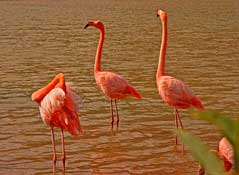
Head to Punta Suarez on Española Island. The southernmostisland in the Galapagos archipelago is home to several wildlife species,including masked and blue-footed boobies. A hike to the top of the cliff makesfor spectacular photo opportunities.
Punta Suarez on the western side of Española Island (also called Hood) isspectacular: gargantuan waves break on jagged cliffs and large bird coloniesthickly populate the interior of the island; there is a distinct feel ofdesolate wilderness here. The Waved Albatross is seen here from April toDecember during its mating/nesting season. This bird leaves land betweenJanuary and March each year to make its annual odyssey far out to sea.Amazingly, Española is the nesting site to virtually the entire world populationof this species, with more than 12000 pairs residing here. Large numbers ofMasked and Blue-footed Boobies are also found here, Red-billed Tropic Birdsdash madly through the air, and both Marine Iguanas and sea lions are common. Ahuge blowhole, where the surf is forced through a natural rock formationspouting seawater 15 to 20 m (49 – 66 ft) into the air, adds to the island'simpression of untamed beauty.
Follow the trail through a rookery and learn the geological history of theisland from our naturalist, including its dramatic volcanic features, climate,flora and fauna. Sail in the afternoon to Garner Bay, an excellent swimming andsnorkelling site
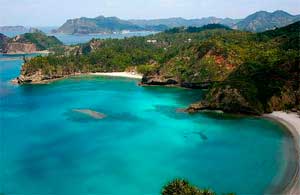
Reach San Cristóbal in the morning. San Cristóbal is theeasternmost island of Galapagos and one of the oldest. Its principal town isPuerto Baquerizo Moreno, the capital of the Galapagos. Disembark afterbreakfast then we visit the interpretation center, and transfer to the airportfor our flight to Quito. Transfer to our group hotel upon arrival, and enjoyone last night on the town.
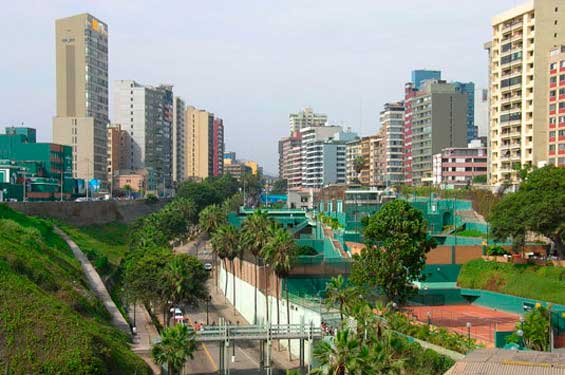
You are on your own to transfer back to the airport foryour flight to Lima (flight must be booked and paid for as part of yourinternational ticket). Arrive in Lima at any time. There are no plannedactivities so check into our hotel and enjoy the city.
Known as the City of Kings, Peru's capital city Lima was founded by FranciscoPizarro on the Day of the Three Kings (Epiphany) in 1535. The Plaza de Armas isthe heart of old Lima, and it is here you find the Cathedral, Government Palaceand Archbishop's Palace. The Cathedral dates back to the 1700s and houses theremains of the conquistador Pizarro. To get a feel for colonial Lima, take acab to the Plaza de Armas and watch the changing of the Palace Guard in theafternoon. Walk the streets surrounding the Jirón de la Unión for greatexamples of Spanish-colonial architecture and to get a taste for life in alarge South American city. An optional city tour visits many of the city'shighlights.
There are many fine museums in and around the city, including the Museo RafaelLarco Herrera, which houses an equally impressive collection of pottery,mummies and textiles from the Paracas and Nazca cultures. The more affluentcoastal districts of Miraflores, Barranco and San Isidro offer good nightlifeand cafés all within walking distance. Limeños (Lima's residents) are friendly,and the city is filled with excellent restaurants; seafood lovers in particularshould be sure to try a ceviche, for which Lima is well known.
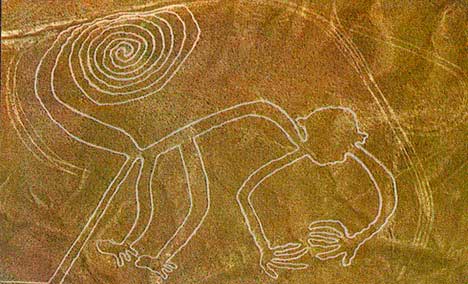
Breakfast. Early morning bus to Ica for a visit to the Nazca Lines, where we board an airplane to fly over the mysterious lines of Nazca
Night bus ride to Arequipa. Overnight on board.
Monasterio de Santa Catalina Reception and transfer to the hotel. After a little time to rest, we will initiate the tour visiting the White city of Arequipa. We will visit the Main Square, which presents a beautiful bronze fountain of three plates crowned with the figure of a soldier of XVI century. Here we will be able to appreciate The Church of the Company of Jesus Christ. Next we will visit the Monastery of Santa Catalina who was a center of absolute retreat, which stayed closed to the public by centuries, today is harmoniously recovered and opened. It allows us to appreciate how the city of Arequipa was in the XVII century. We will see its streets, gardens, walls of sillar, etc. Immediately we will be transferred to the beautiful and green countryside of the Yanahuara Viewpoint, where we will have a privileged view of the city and Volcanoes like the Misti, Pichupichu and Chachani. Return to the Hotel. Overnight in Arequipa.
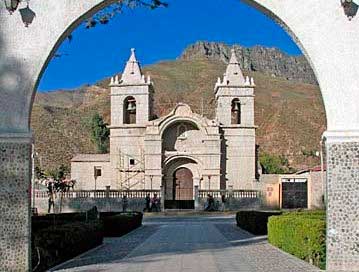
Chivay ChurchBreakfast. Early in the morning we will start our trip to the Colca Valley located in the Province of Caylloma at 3 600masl. In our way we will pass by the district of Yura, Pampa Cañahua, where the vicunas can be appreciated. We will pass through the old crater of Chucure volcano. Later, we will arrive at Patapampa, the highest point pf the tour (4 800masl). From this point, the maximum number of volcanoes that exist together in the department of Arequipa can be appreciated. We will arrive at the town of Chivay and we will settle ourselves in the hotel. Soon we will have a time to have lunch. Also we will have the chance to visit the thermal baths of La Calera (optional). Overnight in Chivay.
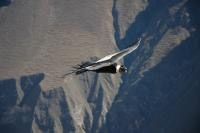
The Condor FlightBreakfast. This day we willvisit the Cross of the Condor, a place that has an impressive View of thevalley and from there we will be able to appreciate the flight of the condorand the depth of the canyon (3 400meters of depth). At Return, we will be ableto visit the town of Pinchillo, the Hanging PRE-Inca tombs, Litomoquetas, thetown of Maca, Achola, the town of Yanque and Chivay. Lunch in restaurant ofChivay (lunch on behalf of passenger). Return to the city of Arequipa.Overnight in Arequipa.
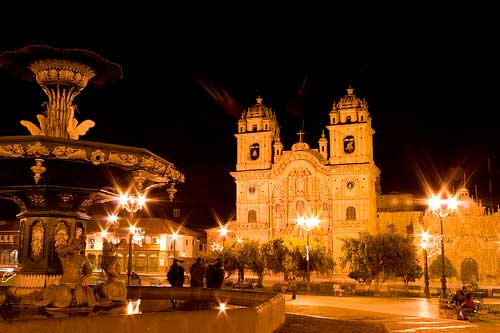
Breakfast, transfer from the hotel to the airport fly to Cusco. In Cusco, reception, welcome in Cusco Main Square and transfer to the chosen hotel ,Free day, you can visit the Capital of the Inkas on your on step or take this day for a rest. Overnight in Cusco.
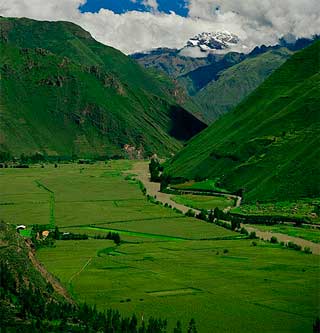
Breakfast. In the morning we will go to the town of Pisaq (located at 50 Pisac Archaeological Complexminutes from Cusco), where we will appreciate the archaeological complex (20 minutes from town). Also, we will have the chance to visit the Typical Artisan Market and the Main Square. We continue by one side of the Vilcanota river, until arriving to Urubamba, where we will have an exquisite lunch buffet. After that, we will discover Ollantaytambo, one of the last living Inca towns. This is so because their streets maintain the same outline to the one of the time of the Incas. We will visit the wonderful archaeological complex located there overnight in this beautifull Village.
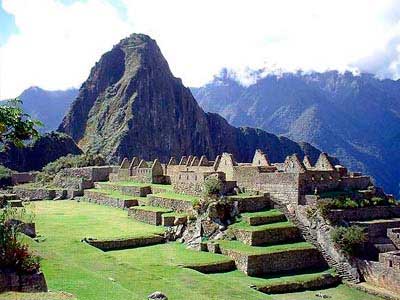
Machu Picchu: Side View Breakfast. Very early in the morning breakfast and after that transfer to the train station. The train leaves from Ollantaytambo and arrives to the Machu Picchu town (AguasCalientes) station after 2 hours aprox. Immediately we will board the bus that will take us to Machu Picchu. We will continue with a guided visit in this magical place for about 2 hours, knowing the temple of the three windows, the solar clock, among others. At the end, we will have a free time, where the buswill pick up us and take us to the town of Aguas Calientes. We'll take the train and a bus to return to Cusco. Overnight in Cusco.
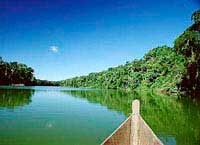
Manu River We leave Cusco early in the morning in our specialized overland vehicles. At approximatelymid-morning we visit the interesting tombs of Ninamarca, commonly known as"Chullpas". We continue to Paucartambo, a pictures que Spanish colonial town,and then to the Acjanacu pass, which marks the beginning of the Cultural Zoneof Manu Biosphere Reserve. There, a thick cloak of clouds provides perpetualhumidity and makes an ideal habitat for epiphytic plants such as bromeliads.This varied and fascinating world is home of the Cock of the Rock, SpectacledBear, Orchids, Tree Ferns (one of the oldest living plants), mosses andlichens. This cloud forest exists between 2,000 and 3,500masl. and at least 50%of the plant specimens found here are endemic to this region. Overnight inLodge.
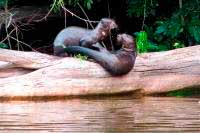
OtorongoToday we will wake up veryearly to observe the Cock of the Rock (Rupicola peruviana), Peru's nationalbird from a platform. The male birds are a vibrant reddish orange, and as manyas several dozen come together for an exhibition of a mating ritual dance in a placecalled Lek. The males display their crest, showing off and posturing for the females. The females, fewer in number, watch the show to select the most suitable males. After breakfast we continue in our overland transport down the narrow road between waterfalls and canyons toward the town of Pilcopata town. A30 minutes bus ride to the port of Atalaya where we will board our coveredoutboard motor boat and head down to the Alto Madre de Dios River forapproximately 30 minutes towards our Lodge where we will spend the next one night. The Lodge is located in a transition zone between high and low jungle(600masl to 1,150masl, 1,200 to 3,450 feet) encompassing different habitats. Giant Otter in ManuThis altitude range explains the high diversity of wildlife found around this lodge, so immediately after breakfast, we will start a shortride by boat for 5 minutes to visit a small lake near to the Alto Madre de Dios River. There we are going to have the chance to see the Hoatzin, a primitivebird, white caimans, many species of birds, insects, etc. then we will walk for 30 minutes. During the hike our guide will talk about insects, medicinalplants, trees, reptiles, mammals, etc. until we reach the Machuwasi Lagoon were we will install the telescope to observe the beautiful and interesting birds.Later, we will have the opportunity to make the Canopy Tour. It consists onhaving our guests traverse from tree to tree and platform to platform usingpulleys on horizontal traverse cables zip lines, as they sail through thetreetops of the tropical rainforest canopy, and over the trails far below.Expert guides assist you in this exciting journey through the different layersof the virgin rain forests and explain what's going on around you from the timeyou leave the ground until you rappel back down to the forest floor. Overnightin lodge.
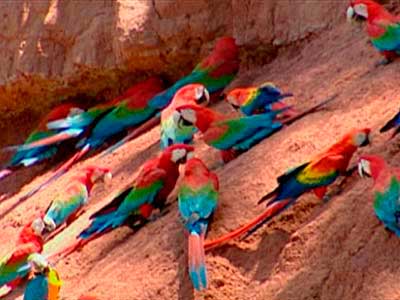
Minutes to go to the Collpa, an argillaceouswall in one side of the river where the different specimens of parrots like thedark-brown blue, parrot white eye head and the Macaw Maracano, among others, gothere each morning to extract and to lick clay pieces that contain necessary mineralsfor their dietetic balance. When finalizing this daily activity, we willcontinue in the boat towards the Port of Atalaya, where the bus is waiting totake us back to the city of Cusco, arriving at this city at night. Overnight in Cusco.
Breakfast. Early in the morning we will be translated to the tourist bus Andahuaylillas Churchstation, to start our trio to Puno. During the trip we will be able to see amazing landscapes and visit interesting archaeological sites like Raqchi, Andahuaylillas and Pukara, we will enjoy a buffet lunch and we will enjoy drinks during all our way. Arrival at Puno. Transfer to the Hotel. Overnight in Puno.
Breakfast. In the morning (7: 30hrs.) we will go to the port of Puno, where we will begin our lacustrine adventure in very quick boats. We will arrive quickly to the floating Island of the Uros, which are a set of floating islands made of totora, inhabited by the Uros, people who descend from one of the oldest civilizations of America. We will be able to appreciate its peculiar lifestyle Uros Islandand its creations, like the elaboration of dissected animal and tweeds. We will have the afternoon free for personal activities. Next we will visit Taquile Island. Inside, we will visit the town and we will have a time for exploration and shopping inside the community. We will return in the evening to Puno. Overnight in Puno.
Breakfast. Free morning. At an appropriate time transfer to the Juliaca Airport to board the flight to Lima. In Lima, reception and transfer to your hotel.
Our Last supper, and Overnight in Lima.
Depart at any time.
 5/5 stars
5/5 stars
Quede totalmente satisfecha con el tours desde la hora que nos recogieron del aeropuerto los guías, visitas turísticas, hoteles y despacho de retorno al aeropuerto. Buena coordinación, super amables
 5/5 stars
5/5 stars
Mi viaje a Panamá fue sorprendente. No tuve que pensar en nada: desde los traslados hasta los tours, todo estaba coordinado al milímetro. Qué tranquilidad poder enfocarme solo en disfrutar, sin correr ni improvisar. Así deberían ser todos los viajes.
 5/5 stars
5/5 stars
Fue una escapada a Cartagena que terminó siendo mucho más que un viaje. La mezcla de historia, mar y alegría me envolvió por completo. Todo salió tan bien que parecía que alguien había leído mi mente y organizado exactamente lo que necesitaba.

Committed to quality, we are ISO 9001 certified, guaranteeing excellence in our services.

With ISO 14001, we prioritize environmental sustainability, reducing our impact on the planet.

We are an official agency and tour operator, ensuring a unique and high-quality travel experience.
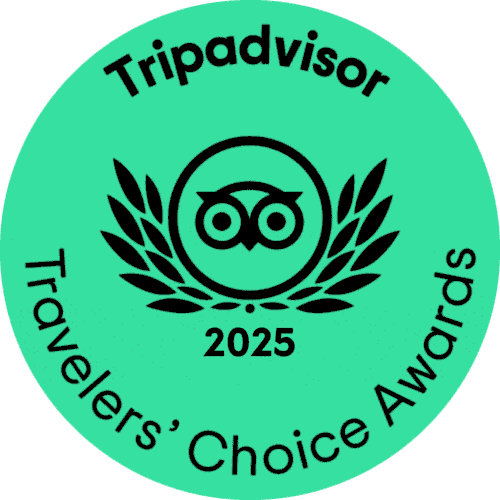
The Traveler's Choice Award in 2025, a testament to our dedication to exceptional travel experiences.



